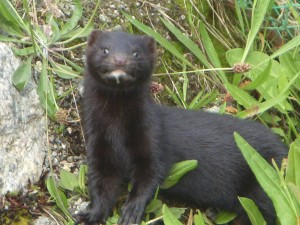 Rivers such as the Nairn, Findhorn, Conon and Beauly are relatively quiet for bird life in the winter months. A walk along any of these river banks in winter is only likely to record a dipper, that small dumpy bird that not only stays but also sings. In the last week or so all has changed and a similar walk will give a wealth of birds to whet anyone’s appetite. The dippers are still there and, as they are one of the earliest birds to nest, they will be feeding chicks. I watched one on the River Nairn last week that was feeding and it was almost mystifying to see it literally walk under the water out of sight. They have the ability to walk under water and feed and will just walk in or, as the one did last week, jump off a rounded stone and dived in. It was very shallow water and several times I could see its back break the surface but never its head.
Rivers such as the Nairn, Findhorn, Conon and Beauly are relatively quiet for bird life in the winter months. A walk along any of these river banks in winter is only likely to record a dipper, that small dumpy bird that not only stays but also sings. In the last week or so all has changed and a similar walk will give a wealth of birds to whet anyone’s appetite. The dippers are still there and, as they are one of the earliest birds to nest, they will be feeding chicks. I watched one on the River Nairn last week that was feeding and it was almost mystifying to see it literally walk under the water out of sight. They have the ability to walk under water and feed and will just walk in or, as the one did last week, jump off a rounded stone and dived in. It was very shallow water and several times I could see its back break the surface but never its head.
As with all other areas from woodland to loch and hillside to glen one secret of watching wildlife is to just stay in one place and try and blend in with the surroundings. A large tree behind you is a good idea or a bank, whatever breaks up your outline. Keep reasonably still and soon wildlife will begin to accept and ignore you. In the case of rivers, the bank is ideal as a backcloth particularly at this time of year when many birds have already set up their territories and will be getting on with their breeding season. Sandy banks near the rivers are good places at this time of the year as the sand martins are now refurbishing their last year’s burrows or, in some cases, excavating new ones. The nest hole is excavated by both males and females and may be two feet long. The nest chamber at the end is lined with grass and feathers. Unfortunately, in the Highlands, sand martin colonies suffer from severe spates after heavy rain and can be flooded out.
Whilst the surrounding fields adjoining rivers will hold breeding curlews, lapwings and oystercatchers, there are two birds that are more closely linked to the river. One is the very colourful grey wagtail whose nest is built close to the water in a hole or crevice in a wall, bank or other protected sites such as bridges or among tree roots. The other bird is a migrant, spending its winter in West Africa, the common sandpiper. Whilst some of these small waders will stay and breed in the Highlands, many others are on their way to Scandinavian breeding grounds. Common sandpipers, as with most other waders, nest on the ground and, although the nest and eggs may be concealed in vegetation, they are still very prone to predators such as crows and the increasingly present mink.
Just occasionally along the river banks there may be colonies of gulls nesting, sometimes in large numbers. These are mainly common gulls but there may be black-headed gulls mixed in with them. Predation is again a main concern but one of the ideas of nesting in colonies is that the large numbers of gulls may dive bomb a predator and even drive it away. Another bird to look out for along such rivers is another migrant, albeit a large one, as ospreys sometimes fish in such places. We may think of ospreys diving after fish into lochs and even fish farms but they also freely take fish from rivers.
Tags: highland wildlife
